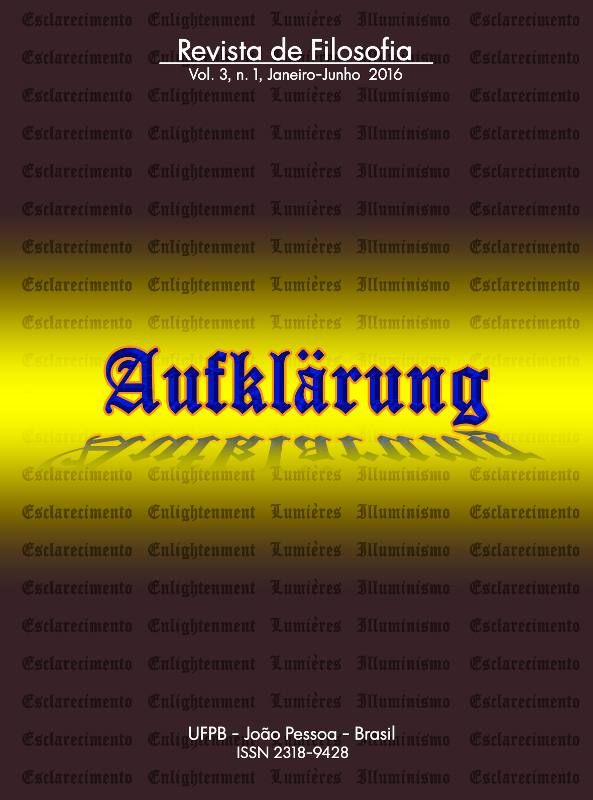On rethoric of the visible to distribution of the sensible: the policy of the esthetic in J. Rancière
DOI:
https://doi.org/10.18012/arf.2016.23425Keywords:
political action, artistic creation, emancipation, common sensibility, profanationAbstract
The present paper aims to investigate the critique of the French philosopher Jacques Rancière to a traditional way of looking the relationship between politics and art appropriated for a specific current of social criticism that examines political vocation of artistic creation as simple privileged means of showing the real domination behind the numerous other images released to us. Against this perspective, Rancière proposes to reconsider the logic that is involved in the common distribution of the sensible, the audible and speakable while real political vocation of art, since he believes that political action is precisely the one that changes the places and the calculation of bodies organized by police device.Downloads
References
AGAMBEN, Giorgio. Homo sacer: o poder soberano e a vida nua I. Trad. Henrique Burigo. Belo horizonte: Editora UFMG, 2002.
_______. A política da profanação: entrevista a Folha de S. Paulo. Trad. Vladimir Safatle. Disponível em: http://www1.folha.uol.com.br/fsp/mais/fs1809200505.htm. Acessado em: 18 de setembro de 2005.
_______. A linguagem e a morte. Trad. Hentique Burigo. Belo Horizonte: Editora UFMG, 2006.
_______. Profanações. Trad. Selvino J. Assmann. São Paulo: Boitempo, 2007.
_______. O que resta de Auschwitz: o arquivo e a testemunha (Homo Sacer III). Trad. Selvino J. Assmann. São Paulo: Boitempo, 2008. (Estado de Sítio).
_______. O reino e a glória: uma genealogia teológica da economia e do governo: homo sacer, II, 2. Trad. Selvino J. Assmann. São Paulo: Boitempo, 2011 (Estado de Sítio).
_______. O que é um povo? In: DIAS, Bruno Peixe; NEVES, José (org.). A política dos muitos: povo, classe e multidão. Lisboa: Tinta-da-China, 2011b.
BORIE, Monique; ROUGEMONT, Martine de; SCHERER, Jacques (org.). Estética teatral: textos e Platão a Brecht. Trad. Helena Barbas. Lisboa: Fundação Calouste Gulbenkian, 2004.
RANCIÈRE, Jacques. O espectador emancipado. Trad. José Miranda Justo. Lisboa: Orfeu Negro, 2010.
_______. The politic of Aesthetic: the distribution of the sensible. Trad. and introd. Gabriel Rockhill. London and New York: Continuum, 2004.
_______. O tempo da emancipação já passou? In: SILVA, Rodrigo; NAZARÉ, Leonor (org.). A república por vir: arte, política e pensamento para o século XXI. Lisboa: Fundação Calouste Gulbenkian, 2011.
_______. A comunidade como dissentimento. In: DIAS, Bruno Peixe; NEVES, José (org.). A política dos muitos: povo, classe e multidão. Lisboa: Tinta-da-China, 2011.
ŽIŽEK, Slavoj. The Lesson of Rancière: afterword by Slavoj Žižek. In: The politic of Aesthetic: the distribution of the sensible. Trad. and introd. Gabriel Rockhill. London and New York: Continuum, 2004.
Additional Files
Published
How to Cite
Issue
Section
License
Journal general policy
1.This journal works under a Creative Commons License aplied to online journals. That icence can be read in the following link: Creative Commons Attribution 4.0 International (CC BY 4.0).
2.Accordingly to this License, a)the journal declares that authors hold the copyright of their articles without restrictions, and they can archieve them as post-print elsewhere. b)the journal allow the author(s) to retain publishing rights without restrictions.
Metadata Policy for information describing items in the repository
1. Anyone may access the metadata free of charge at anytime.
2.The metadata may be re-used in any medium without prior permission, even commercial purposes provided the OAI Identifier or a link to the original metadata record are given, under the terms of a CC BY license refered for the Journal.







































